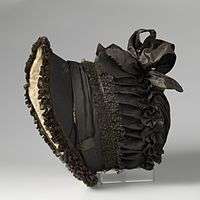Poke bonnet


A poke bonnet (sometimes also referred to as a Neapolitan bonnet) is a women's bonnet, featuring a small crown and wide and rounded front brim. Typically this extends beyond the face. It has been suggested that the name came about because the bonnet was designed in such a way that the wearer's hair could be contained within the bonnet.[1] Poke may also refer to the brim itself, which jutted out beyond the wearer's face.[2]
Characteristics
There were many variations of the style, which remained popular throughout much of the 19th century.[3] The Metropolitan Museum of Art notes that the poke usually had a small crown combined with a large brim extending beyond the face, providing a large surface for decoration.[4]
This prominent brim shaded the face and, over time increased in size so that the wearer's face could only be seen from the front.[5] Typically, the bonnet would be secured by ribbons tied under the chin, which might also wrap around the bottom of the bonnet's crown, similar to a hatband. An 1830s version of the poke bonnet with ornate ribbon wrapping forms part of the Victoria and Albert Museum archive.[6]

History of the design
The poke bonnet came into fashion at the beginning of the 19th century. It is first mentioned in an 1807 fashion report in The Times; the report describes designs made of willow or velvet with long ribbons and full bows on one side of the hat.[7]
By the 1830s, Englishwomen had adopted the poke bonnet. The new styles became widely popular and made the aristocracy less visibly distinct from the respectable middle classes.[8] The style is modest and was in line with English fashions after the ascension of Queen Victoria.[9]
A poke bonnet features prominently in the illustrations of Beatrix Potter's Tale of Jemima Puddle-Duck. Another appears in the First World War-era music hall song "In your little poke bonnet and shawl".[10]
See also
References
- ↑ "Poke Bonnet". nga.gov. National Gallery of Art. Retrieved 23 July 2015.
- ↑ "Poke". collinsdictionary.com. Collins Dictionary. Retrieved 23 July 2015.
- ↑ Brooks Picken, Mary. A Dictionary of Costume and Fashion: Historic and Modern (1999 ed.). United States: Dover Publications. p. 27. ISBN 0486402940. Retrieved 22 July 2015.
- ↑ "Poke bonnet". metmuseum.org. Metropolitan Museum of Art. Retrieved 22 July 2015.
- ↑ "Poke bonnet". britannica.com. Encyclopaedia Britannica. Retrieved 23 July 2015.
- ↑ "Poke Bonnet". vam.ac.uk. Victoria and Albert Museum. Retrieved 23 July 2015.
- ↑ "Fashions for November" (7219). The Times. 1 December 1807.
- ↑ Judith S. Lewis (2003). Sacred to Female Patriotism: Gender, Class, and Politics in Late Georgian Britain. p. 184. ISBN 0415944112.
- ↑ Metropolitan Museum of Art, Mourning Poke Bonnet Collection.
- ↑ "1914, English, Printed music edition: In your little poke bonnet and shawl / written and composed by Alf. J. Lawrance. [music]". trove.nla.gov.au. National Library of Australia. Retrieved 23 July 2015.
| Wikimedia Commons has media related to Bonnets. |